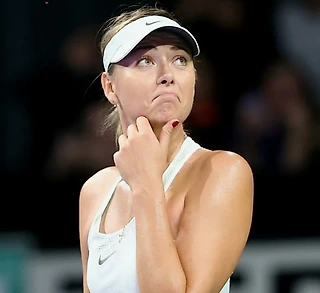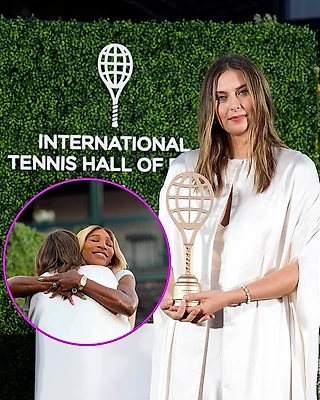Buckling Down
Выставил статью Бодо. Он не любит Марию и поэтому интересно что написал.
Thursday, March 28, 2013 /by Peter Bodo
MIAMI, Fla.—It was a two-set WTA match, but it lasted just seconds shy of two-and-a-half hours. The winner hit a dazzling 44 winners—fully 31 more than the loser—yet she was constantly in danger and had to fend off three set points before closing it out. The loser didn’t hit a single ace, but posted an 84 percent first-serve conversion percentage.
By now, you know there’s only one player who can leave those marks on the stat sheet: Italy’s finest, WTA No. 7 Sara Errani. On Wednesday in Key Biscayne, she fought one of the guerilla wars for which she’s become famous, pushing No. 3 seed Maria Sharapova to the brink—maybe not the brink of a loss, but certainly the brink of a nervous breakdown.
You’d think it would have been a lot easier to dispatch a woman who entered the match 0-25 against Top 5 players, and 0-11 against the Top 2. But Errani represents a special brand of torment for the likes of Sharapova. By the time Sharapova completed her 7-5, 7-5 quarterfinal win at the Sony Open, her signature high-pitched shriek had morphed into a prolonged, deep growl, but the dachshund attached to her jowl still wouldn’t let go.
When Errani was broken in this match, she often broke back. When Sharapova belted an inside-out winner, Errani often responded by immediately forcing her into an error on the next point. This was a match loaded with blown (or dismissed) 30-love leads, deuces, and a staggering 29 combined break points; each woman converted a third of them—four by Errani, six by Sharapova.
These fluctuations had less to do with the wind in Miami or the windpipe of either player than the way they match up: Sharapova goes for broke, Errani tries to make her opponents go broke. Errani’s game plan is to impel her opponents to hit one more shot than they’re capable of successfully making, while Sharapova’s shtick is to hit one fewer than what most people would consider appropriate for winning a point. Basically, it’s a square peg against a round hole, and each woman is capable of frustrating the other.
“I feel very lucky that I’m through,” Sharapova said when it was over. “She had her chances to win that second set, so who knows what would have happened? She’s extremely difficult. She makes you work. And she doesn’t have the height, doesn’t have the power, but her ability to get so many balls back, to stay consistent—and to do it over and over again. . . she’s able to do those things very well when she has time.”
Aye, there’s the rub in this match. As Errani said: “I try to play my game, try to stay there, try to run, try to play to have more time to hit the ball and play my game. I try to move the ball but with her the points are very fast and short—and I like another style of game. With Maria, you don’t have time to do what you might with another player. For sure you have tactic, but for her that’s not very important because she makes the point short.”
In the immortal words of former heavyweight champion Mike Tyson, “Everybody has a plan until they get punched in the face.”
For a good part of the first set, though, many of the punches Sharapova threw hit nothing but the court—the portion of it that lies outside of the lines. It was windy and bright, and let’s face it, the eyes of 6’2” Sharapova are a lot closer to the sun than those of the diminutive (5’4”) Errani’s.
Yet one of Sharapova’s unheralded achievements is the ability to slough off those double faults that can cause a player to unravel and continue to attack the ball with undiminished relish. Time and again today, she’d crack a double fault and follow it up with a prodigious winner before the titters and groans in the crowd faded.
Those errant serves have a modest dividend, in that they play in an opponent’s mind as well. If Sharapova just hit a double fault at deuce, wouldn’t you nudge over to the ad-side thinking, “Wow, one more of those and I’m a happy camper.”
On top of that, some of Sharapova’s misfires can be put down to a mindset that’s just as willing to assume risk at the service notch as at the baseline. As Errani observed: “When she serves second serves, 90 or 95 miles (per hour), she can make double faults. But you have to count also the points when she do a second serve that go in, and win the point for her because it is so flat and powerful.”
One of the great improvements in Sharapova’s game in recent times has been her ability to step in and tag the big forehand, especially the inside-out variety, when one of those stinging 95 M.P.H. second serves is returned. When the ball is a blur, just getting it back into play is the mandate. The desire to powder the ball if it does cross back over the net has grown in Sharapova.
As the first set wore on, Sharapova overcame her fear of serving. She clung to a one-break lead until Errani ran the table on Sharapova’s serve in the 10th game to eliminate the lead. But Sharapova broke again in the very next game, after a rare Errani double fault brought up deuce. Sharapova jumped on her next opportunity and hit a cross-court forehand winner for break point, then traded warp-speed groundstrokes with Errani until the latter drive a down-the-line forehand out. Sharapova served it out, ending the set with an ace and a service winner.
The second set continued the pattern of long games and intense exchanges that only a jackrabbit-quick player like Errani can prolong into rallies. The women exchanged four straight breaks starting with Errani serving at 2-2, and it began to look like Errani’s relentless consistency was beginning to take its toll on Sharapova. The match teetered on brink, ready to fall on either player’s side, when Errani had three set points in the ninth game.
Sharapova brushed aside the first one with a cross-court backhand winner. She addressed the next two with a pair of stone-cold inside-out forehand winners. That left her at deuce, and she secured the hold with a successful smash and a backhand volley winner. Errani surely suffered a letdown after that impressive escape, for she was broken at 15 in the next game, and Sharapova went on to serve it out with no further drama.
Mulling over that critical ninth game, Sharapova said: “I don’t feel like I should have been in that position (three break-points down). It’s great that I got myself out of it. But you know, I was up 30-love on my serve and those are the type of games that against these type of players you need to buckle down and win.”
This was the second time in as many matches that Errani had set points against Sharapova, only to fall short by a hair. Is there any doubt that she’s the best 0-26 challenger to the top players?











Майами, Флорида.
Это был двух-сетовый матч WTA, но продолжался он всего на пару секунд меньше, чем 2,5 часа. Победительница сделала поразительные 44 виннера, – на 31 (!) больше, чем проигравшая – но постоянно была в опасности и была вынуждена отыграть 3 сет-бола прежде чем довести дело до конца. Проигравшая не сделала ни одного эйса, но продемонстрировала 84%-ную реализацию первой подачи.
К настоящему моменту вы знаете, что существует только один игрок, способный оставить такие отметки на листе статистики: лучшая в Италия и 7-ая в WTA Сара Эррани. В среду в Ки Бискейне она сражалась в одной из партизанских войн, которые сделали её известными, подталкивая 3-ю сеянную Марию Шарапову если не к грани поражения, то без сомнения к опасности нервного срыва.
Вы, вероятно, подумаете, что расправиться с женщиной, имеющей к началу матча баланс встреч 0-25 с игроками топ-5 и 0-11 с игроками топ-2, можно было бы значительно проще. Но Эррани представляет собой особый источник мучений для таких, как Шарапова. К тому времени, как Шарапова оформила свою чертвертьфинальную победу на Сони Опен со счетом 7-5, 7-5, ее фирменный пронзительный крик превратился в протяжный глубокий рык, но такса, держащая ее за горло, все еще не сдавалась.
Когда Эррани проигрывала в этом матче свою подачу, ей часто удавалось сделать обратный брейк. Когда Шарапова делала неберущийся виннер, Эррани часто отвечала тем, что немедленно заставляла ее сделать ошибку в следующем розыгрыше. Это был матч, наполненный растранжиренным (или упущенным) преимуществом в 30-0, счетом «ровно» и 29-ю брейк-пойнтами на двоих; каждая женщина реализовала треть из них: 4 – Эррани и 6 – Шарапова.
Эти перепады мало связаны с ветром в Майами или с дыханием игроков, тут другая зависимость: Шарапова старается изо всех сил – Эррани пытается заставить свою оппонентку идти ва-банк. План Эррани на игру состоит в том, чтобы вынуждать своих соперниц сделать на один удар больше, чем они могут сделать успешно, в то время как «трюк» Шараповой заключается в том, что сделать на один удар меньше, чем большинство сочло бы необходимым для выигрыша мяча. По правде говоря, одна подходит другой, как корове седло (дословно: круглый стержень в квадратной дыре), и каждая способна расстроить планы другой.
«Я считаю большой удачей выход в следующий круг», - сказала Шарапова по окончании матча. «У нее были шансы выиграть второй сет, и кто знает, что могло бы случиться? С ней невероятно сложно. Она заставляет тебя работать. И пусть у нее нет высокого роста или выдающейся силы, но ее способность возвращать так много мячей, оставаться последовательной… Она может делать эти вещи очень хорошо, если у нее есть время».
Согласен, в этом матче есть неожиданное столкновение. Как сказала Эррани: «Я пытаюсь играть в свою игру, пытаюсь оставаться в ней, пытаюсь бегать, пытаюсь играть, чтобы иметь больше времени на подготовку удара и играть в свою игру. Я пытаюсь перемещать мяч, но с ней розыгрыши очень короткие и быстрые, а мне нравится другой стиль игры. С Марией у тебя нет того времени, которое могло бы быть с другими игроками. Конечно, у тебя есть тактика, но для нее это не очень важно, потому что она делает розыгрыши короткими».
Когда у Эррани есть время, она использует весь широкий арсенал своих технических возможностей, так что мой стартовый рывок связан с тем, что я не давала ей времени на размышления. Но большую часть матча мне этого не удавалось, именно поэтому она возвращалась в игру и выглядела очень здорово.
Я хочу играть, как можно агрессивнее – это мое. Мне не нравится ждать ошибок соперниц, поэтому я собралась и нанесла несколько отличных ударов на сетболах у Эррани. Полагаю, мне очень повезло, что я смогла пройти дальше. У Сары были шансы выиграть второй сет – и кто знает, что тогда могло случиться. Рада, что снова сыграю на стадии полуфинала.
Связка турниров Индиан-Уэллс – Майами – одна из самых сложных в сезоне. Приходится играть так много матчей, многие из которых проходят поздно вечером, восстанавливаться. А расположение городов на разных побережьях? Пять часов перелета – это вам не просто так. Да и условия совершенно разные. Да, между матчами бывают выходные, но это одна из самых сложных связок – это точно», – цитирует Шарапову официальный сайт WTA.
Большую часть первого сета, тем не менее, многие из шараповских «кулаков в лицо» попадали только корту – по той его части, которая находится за пределами линий. Было ветрено и солнечно, и давайте признаем, что глаза Шараповой, находящиеся на высоте 188 см, гораздо ближе к солнцу, чем глаза миниатюрной (162 см) Эррани.
______________________________________________________
Если интересно, остальное доперевожу вечером.
Эти «блуждающие» подачи приносят умеренные дивиденды, в том смысле, что они влияют на состояние соперницы. Если Шарапова только что сделала двойную ошибку при счете «ровно», ты волей-неволей начинаешь думать: «Ух ты, еще один раз так, и я отдыхаю».
В довершение к этому некоторые из шараповских осечек могут привести к такому состоянию, когда ты рискуешь как на подаче, так и на задней линии. Как заметила Эррани: «Когда она подает вторым мячом со скоростью 90 или 95 миль (в час), она может делать двойные. Но следует иметь в виду и те мячи, когда она попадает второй подачей и выигрывает ей очко, потому что она (подача) очень плоская и мощная».
Одно из серьезнейших улучшений в игре Шараповой в последнее время – ее способность войти в корт и пробить мощный форхенд, особенно его разновидность «влетел и вылетел», после ответа на одну из этих хлестких вторых подач со скоростью 95 км/ч. Когда мяч смазан, твоя обязанность – просто ввести его обратно в игру. В Шараповой появилось желание стирать мяч в порошок, как только он перелетел через сетку.
Пока медленно тянулся первый сет, Шарапова преодолела свой страх на подаче. Она удерживала разницу в один брейк до тех пор, пока Эррани не взяла «под ноль» подачу Шараповой в десятом гейме, уничтожив ее преимущество. Но Шарапова сделала брейк в следующем же гейме, когда после редкой у Эррани двойной ошибки счет стал «ровно». Шарапова набросилась на представившуюся возможность и заработала брейк-пойнт, пробив навылет кроссом справа, а затем обменивалась с Эррани ударами с отскока на безумной скорости, пока соперница не пробила справа по линии в аут. Шарапова отподавала, завершив сет эйсом и подачей, принимая которую, Эррани ошиблась.
Второй сет продолжался по сценарию длинных геймов и интенсивных ралли, которые не заканчивались быстро только потому, что на другой стороне была быстрая, как заяц, Эррани. Девушки обменялись четырьмя брейками подряд, начиная с подачи Эррани при счете 2-2, и стало казаться, что неумолимая стабильность Эррани начинает сказываться на Шараповой. Матч качался на весах, готовых склониться в сторону любого игрока, когда Эррани заработала 3 сет-бола в девятом гейме.
Шарапова разделалась с первым при помощи кросса слева на вылет. На два следующих она ответила парой хладнокровных «уходящих» виннеров с форхенда. Это привело ее счету «ровно», и она «обеспечила» себе гейм удачным смэшем и виннером ударом слета слева. Эррани, конечно, была разочарована таким впечатляющим спасением, поскольку отдала свою подачу в следующем гейме, а Шарапова продолжила подавать как ни в чем не бывало.
Размышляя о том ключевом девятом гейме, Шарапова сказала: «Я понимаю, что не стоило доводить ситуацию до такого (до трех брейк-пойнтов). Здорово, что я смогла выстоять. Но на моей подаче было 30-0, а это такие геймы против таких игроков, когда надо просто сосредоточиться и выиграть».
За несколько матчей это был второй раз, когда у Эррани были сет-болы против Шараповой, которая была на волоске от поражения. Есть еще какие-то сомнения в том, что Эррани с балансом встреч 0-26 – лучшая из бросающих вызов топ-игрокам?
по поводу таксы очень даже не плохо , на Сару это похоже :)